1998年-2013年社科院考博经济学原理及西方经济学真题
中国社会科学院经济系考博真题导师分数线内部资料

第 2010-293-001 号)。
裴小革,经济系博士生导师。1956 年 10 月出生于北京市。现为中国社会科学院经
济研究所研究员、《资本论》研究中心主任、当代西方经济理论研究室主任,同时为中
国《资本论》研究会秘书长、中国社会科学院研究生院教授、全国经济学名词审定委员
会委员、全国经济贸易名词审定委员会委员、福建师范大学兼职教授。
资料来源育明教育官网:(考博分校) 考博考试信息、辅导课程可咨询育明教育考博分校
育明 考博分校 资料来源: 考博资料、辅导课程 咨询育明考博刘老师
项目《中国近代经济史》1937-1949 卷副主编。主持院级课题《抗战前中国产业经济发 展状况研究》、《中国经济史学数据库》等项目,现担任院创新工程《我国初期工业化》 首席研究员。已发表《民国时期经济政策的沿袭与变异》(2006 年)、《民族工业发展史 话》(2000 年、2011 年)等个人专著,发表了《官产官业处置、收归国有取向与民初经 济政策》(1998 年)等数十篇学术论文。《民国时期经济政策的沿袭与变异》获 2009 年 经济所优秀科研成果奖一等奖,2010 年中国社会科学院优秀成果奖(专著)三等奖。
育明 考博分校 资料来源: 考博资料、辅导课程 咨询育明考博刘老师
中国社会科学院经济系考博真题导师分数线内部资料 一、专业的设置、招生人数及考试科目
院系ቤተ መጻሕፍቲ ባይዱ
专业
(招生人数) (招生人数)
研究方向
导师
考试科目
401 经济系 (14)
①1001 英语
01 经济增长与资本形成
资料来源育明教育官网:(考博分校) 考博考试信息、辅导课程可咨询育明教育考博分校
育明 考博分校 资料来源: 考博资料、辅导课程 咨询育明考博刘老师
中国社会科学院考博历年真题 经济学原理2001
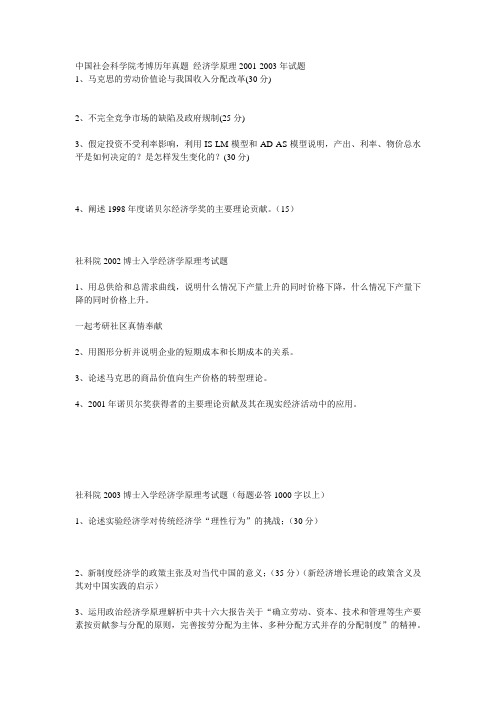
中国社会科学院考博历年真题经济学原理2001-2003年试题
1、马克思的劳动价值论与我国收入分配改革(30分)
2、不完全竞争市场的缺陷及政府规制(25分)
3、假定投资不受利率影响,利用IS-LM模型和AD-AS模型说明,产出、利率、物价总水平是如何决定的?是怎样发生变化的?(30分)
4、阐述1998年度诺贝尔经济学奖的主要理论贡献。
(15)
社科院2002博士入学经济学原理考试题
1、用总供给和总需求曲线,说明什么情况下产量上升的同时价格下降,什么情况下产量下降的同时价格上升。
一起考研社区真情奉献
2、用图形分析并说明企业的短期成本和长期成本的关系。
3、论述马克思的商品价值向生产价格的转型理论。
4、2001年诺贝尔奖获得者的主要理论贡献及其在现实经济活动中的应用。
社科院2003博士入学经济学原理考试题(每题必答1000字以上)
1、论述实验经济学对传统经济学“理性行为”的挑战;(30分)
2、新制度经济学的政策主张及对当代中国的意义;(35分)(新经济增长理论的政策含义及其对中国实践的启示)
3、运用政治经济学原理解析中共十六大报告关于“确立劳动、资本、技术和管理等生产要素按贡献参与分配的原则,完善按劳分配为主体、多种分配方式并存的分配制度”的精神。
(35分)。
社科院博士生入学管理学原理近四年考题
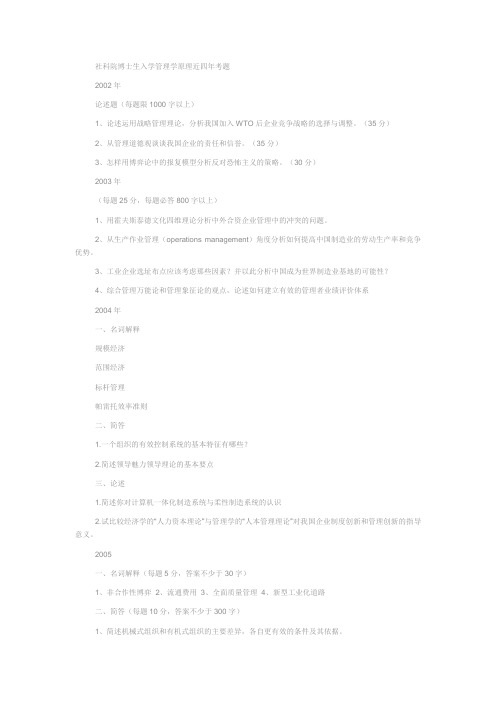
社科院博士生入学管理学原理近四年考题2002年论述题(每题限1000字以上)1、论述运用战略管理理论,分析我国加入WTO后企业竞争战略的选择与调整。
(35分)2、从管理道德观谈谈我国企业的责任和信誉。
(35分)3、怎样用博弈论中的报复模型分析反对恐怖主义的策略。
(30分)2003年(每题25分,每题必答800字以上)1、用霍夫斯泰德文化四维理论分析中外合资企业管理中的冲突的问题。
2、从生产作业管理(operations management)角度分析如何提高中国制造业的劳动生产率和竞争优势。
3、工业企业选址布点应该考虑那些因素?并以此分析中国成为世界制造业基地的可能性?4、综合管理万能论和管理象征论的观点,论述如何建立有效的管理者业绩评价体系2004年一、名词解释规模经济范围经济标杆管理帕雷托效率准则二、简答1.一个组织的有效控制系统的基本特征有哪些?2.简述领导魅力领导理论的基本要点三、论述1.简述你对计算机一体化制造系统与柔性制造系统的认识2.试比较经济学的“人力资本理论”与管理学的“人本管理理论”对我国企业制度创新和管理创新的指导意义。
2005一、名词解释(每题5分,答案不少于30字)1、非合作性博弈2、流通费用3、全面质量管理4、新型工业化道路二、简答(每题10分,答案不少于300字)1、简述机械式组织和有机式组织的主要差异,各自更有效的条件及其依据。
2、概述托马斯人际关系冲突处理二维模式及其基本内容三、论述(每题30分,答案不少于1000字)1、分析和说明金钱在下列理论中的作用:A。
需要层次理论B。
激励保健理论C。
公平理论D。
期望理论E。
具有高成就需要的员工理论2。
简论科学发展观与组织文化的关系。
中国人民大学教育科学研究所2004年博士生入学考试试题(管理学)1、说明实践中的管理者怎样从权变方法的应用中受益?(25分)2、为什么决策被认为是“管理者工作的本质”,组织文化可能从哪些方面影响管理者决策的方式?(25分)3、人员甄选、招聘和职务分析之间具有什么关系?(25分)源:4、宽管理跨度与窄管理跨度,哪个更有效率,为什么?对我国政府管理的意义如何?(25分)山东大学西方经济学试题一、简答(45)1、外部性对资源配置的影响2、福利经济学第二定理3、汇率变动对净出口的影响二、计算15均衡收入、投资、及利率的决定三、论述1、乘数加速数模型评书2/福利经济学分析框架产业经济试题一、简答401、产业结构的影响因素2、产业政策的制定依据3、进入壁垒及原因4、市场结构及主要类型5、自然垄断的定义及特点。
社科院数量经济学专业考博真题解析-育明考研考博

中国社会科学研究院数量经济学专业考博真题解析报考分析一、中国社会科学研究院数量经济学专业考博考试内容分析(育明考博辅导中心)专业招生人数初试内容复试内容020209数量经济学2016年6人①1001英语②2001经济学原理③3043数量经济学①外国语综合能力测试50分(含口语及听力)②专业综合150分(笔试、面试)育明考博辅导中心张老师解析:1、中国社会科学研究院数量经济学专业考博的报录比平均在6:1左右(竞争较激烈)2、本专业有7个研究方向:01经济政策计量分析(李雪松)02宏观经济分析、人口结构与老龄化经济效应分析(李军)03经济模型与经济预测(张涛)04博弈论与宏观经济微观分析(王国成)05数量金融与政策分析(樊明太)06不确定性经济预测与评价(李群)07经济计量分析方法与应用(李金华)3、初试英语拉开的分差较小,两门专业课拉开的分差非常大,要进入复试就必须在两门专业课中取得较高的分数,专业课的复习备考中“信息”和“方向”比单纯的时间投入和努力程度更重要。
4、以同等学力资格报考的考生初试时需加试“政治理论”(考试范围:马克思主义经典选读、中国特色社会主义理论),复试时需加试两门本专业硕士学位主干课程(笔试)。
5、入学考试总成绩=初试成绩*60%+复试成绩*40%。
育明教育考博分校针对中国社会科学研究院数量经济学专业考博开设的辅导课程有:考博英语课程班·专业课课程班·视频班·复试保过班·高端协议班。
每年专业课课程班的平均通过率都在80%以上。
根植育明学校从2006年开始积累的深厚高校资源,整合利用历届育明优秀学员的成功经验与高分资料,为每一位学员构建考博成功的基础保障。
(中国社会科学研究院数量经济与技术经济系考博资料获取、课程咨询育明张老师叩叩:772678537)二、社科院数量经济与技术经济系历年考博复试分数线(育明考博课程中心)育明考博辅导中心张老师解析:1、中国社会科学研究院数量经济与技术经济系共有2个博士招生专业:020209数量经济学120204技术经济及管理,各个专业竞争压力还是比较大的。
名校考博经济学真题
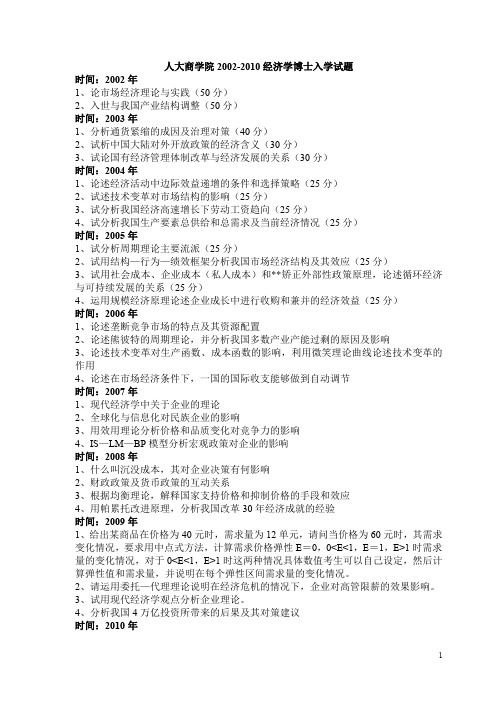
人大商学院2002-2010经济学博士入学试题时间:2002年1、论市场经济理论与实践(50分)2、入世与我国产业结构调整(50分)时间:2003年1、分析通货紧缩的成因及治理对策(40分)2、试析中国大陆对外开放政策的经济含义(30分)3、试论国有经济管理体制改革与经济发展的关系(30分)时间:2004年1、论述经济活动中边际效益递增的条件和选择策略(25分)2、试述技术变革对市场结构的影响(25分)3、试分析我国经济高速增长下劳动工资趋向(25分)4、试分析我国生产要素总供给和总需求及当前经济情况(25分)时间:2005年1、试分析周期理论主要流派(25分)2、试用结构—行为—绩效框架分析我国市场经济结构及其效应(25分)3、试用社会成本、企业成本(私人成本)和**矫正外部性政策原理,论述循环经济与可持续发展的关系(25分)4、运用规模经济原理论述企业成长中进行收购和兼并的经济效益(25分)时间:2006年1、论述垄断竞争市场的特点及其资源配置2、论述熊彼特的周期理论,并分析我国多数产业产能过剩的原因及影响3、论述技术变革对生产函数、成本函数的影响,利用微笑理论曲线论述技术变革的作用4、论述在市场经济条件下,一国的国际收支能够做到自动调节时间:2007年1、现代经济学中关于企业的理论2、全球化与信息化对民族企业的影响3、用效用理论分析价格和品质变化对竞争力的影响4、IS—LM—BP模型分析宏观政策对企业的影响时间:2008年1、什么叫沉没成本,其对企业决策有何影响2、财政政策及货币政策的互动关系3、根据均衡理论,解释国家支持价格和抑制价格的手段和效应4、用帕累托改进原理,分析我国改革30年经济成就的经验时间:2009年1、给出某商品在价格为40元时,需求量为12单元,请问当价格为60元时,其需求变化情况,要求用中点式方法,计算需求价格弹性E=0,0<E<1,E=1,E>1时需求量的变化情况,对于0<E<1,E>1时这两种情况具体数值考生可以自己设定,然后计算弹性值和需求量,并说明在每个弹性区间需求量的变化情况。
社科院经济学原理历年真题
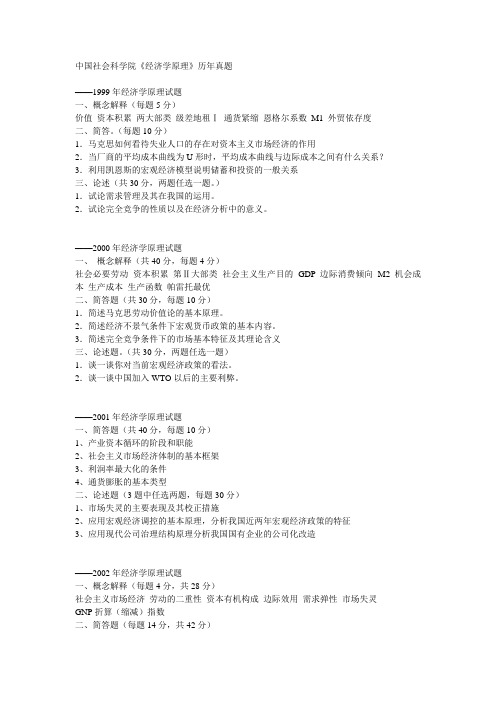
中国社会科学院《经济学原理》历年真题——1999年经济学原理试题一、概念解释(每题5分)价值资本积累两大部类级差地租Ⅰ通货紧缩恩格尔系数M1 外贸依存度二、简答。
(每题10分)1.马克思如何看待失业人口的存在对资本主义市场经济的作用2.当厂商的平均成本曲线为U形时,平均成本曲线与边际成本之间有什么关系?3.利用凯恩斯的宏观经济模型说明储蓄和投资的一般关系三、论述(共30分,两题任选一题。
)1.试论需求管理及其在我国的运用。
2.试论完全竞争的性质以及在经济分析中的意义。
——2000年经济学原理试题一、概念解释(共40分,每题4分)社会必要劳动资本积累第Ⅱ大部类社会主义生产目的GDP 边际消费倾向M2 机会成本生产成本生产函数帕雷托最优二、简答题(共30分,每题10分)1.简述马克思劳动价值论的基本原理。
2.简述经济不景气条件下宏观货币政策的基本内容。
3.简述完全竞争条件下的市场基本特征及其理论含义三、论述题。
(共30分,两题任选一题)1.谈一谈你对当前宏观经济政策的看法。
2.谈一谈中国加入WTO以后的主要利弊。
——2001年经济学原理试题一、简答题(共40分,每题10分)1、产业资本循环的阶段和职能2、社会主义市场经济体制的基本框架3、利润率最大化的条件4、通货膨胀的基本类型二、论述题(3题中任选两题,每题30分)1、市场失灵的主要表现及其校正措施2、应用宏观经济调控的基本原理,分析我国近两年宏观经济政策的特征3、应用现代公司治理结构原理分析我国国有企业的公司化改造——2002年经济学原理试题一、概念解释(每题4分,共28分)社会主义市场经济劳动的二重性资本有机构成边际效用需求弹性市场失灵GNP折算(缩减)指数二、简答题(每题14分,共42分)1、以宏观经济学中的总需求决定论说明扩大政府采购的作用2、试论述社会总资本扩大再生产的实现条件3、作图说明垄断企业的产品价格和产量如何决定三、论述题(选一题,30分)1、比较说明:马克思与西方经济学分别怎样解释市场上的产品价格如何决定?2、马克思如何以劳动价值论来说明资本主义社会国民收入的分配?他的观点与西方经济学中的收入分配理论有何不同?——2003年经济学原理试题一、概念辨析(每题14分,共70分)1、经济学和政治经济学2、价值和生产价格3、资本集中和资本积累4、机会成本和边际成本5、经济增长和经济发展二、论述题(每题40分,共80分)1、谈谈经济学中的静态分析、比较静态分析和动态分析2、西方经济学中的失业理论和我国现阶段的就业问题——2004年经济学原理试题一、名词解释30分绝对剩余价值级差地租II 资本原始积累恩格尔定理无差异曲线二、简答题50分A垄断条件下利润平均化规律会发生那些变化?B浅析规模经济与范围经济的关系!三、论述题70分A生产要素按贡献参与分配的依据及其意义!B论公平与效率的关系!——2005年经济学原理考试试题一、名词解释:每题6分边际效用对剩余价值有效需求自然失业率虚拟资本二、简答题,每题20分1、产业资本循环实现条件是什么?2、完全竞争与不完全竞争的区别和联系?3、IS-LM模型中的产品市场和货币市场实现均衡的机制是什么?三、论述题,每题30分1、产权、产权制度对市场经济发展的意义2、在社会主义市场经济条件下市场机制和宏观调控的关系——2006年经济学原理试题一、名词解释(共30分,每题6分。
2013年南大经济学考博试题,真题解析,复试真题,考博经验,真题笔记
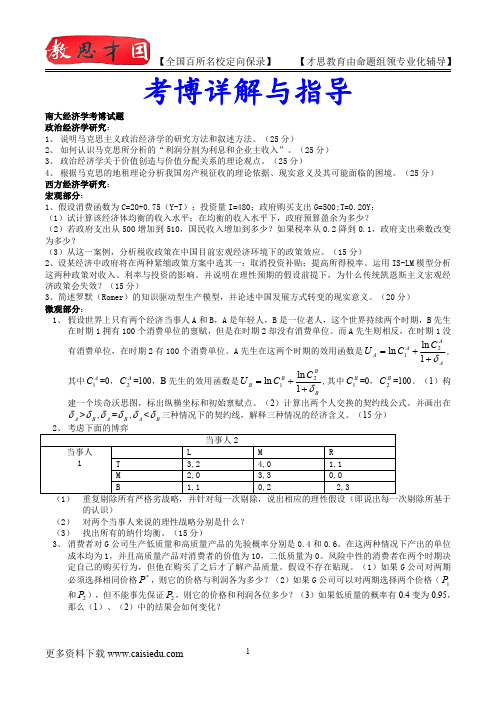
ln C 2A , 1 A
其中 C1 =0, C 2 =100,B 先生的效用函数是 U B ln C1
A A B
ln C 2B B B ,其中 C1 =0, C 2 =100。(1)构 1 B
建一个埃奇沃思图,标出纵横坐标和初始禀赋点。(2)计算出两个人交换的契约线公式。并画出在 A > B , A = B , A < B 三种情况下的契约线,解释三种情况的经济含义。(15 分) 2、 考虑下面的博弈 当事人 2 当事人 L M R 1 T 3,2 4,0 1,1 M 2,0 3,3 0,0 B 1,1 0,2 2,3 (1) 重复剔除所有严格劣战略,并针对每一次剔除,说出相应的理性假设(即说出每一次剔除所基于 的认识) (2) 对两个当事人来说的理性战略分别是什么? (3) 找出所有的纳什均衡。(15 分) 3、 消费者对 G 公司生产低质量和高质量产品的先验概率分别是 0.4 和 0.6。在这两种情况下产出的单位 成本均为 1,并且高质量产品对消费者的价值为 10,二低质量为 0。风险中性的消费者在两个时期决 定自己的购买行为,但他在购买了之后才了解产品质量。假设不存在贴现。(1)如果 G 公司对两期 必须选择相同价格 P ,则它的价格与利润各为多少?(2)如果 G 公司可以对两期选择两个价格( P 1 和 P2 ),但不能事先保证 P2 ,则它的价格和利润各位多少?(3)如果低质量的概率有 0.4 变为 0.95, 那么(1)、(2)中的结果会如何变化?
【全国百所名校定向保录】
【才思教育由命题组领专业化辅导】
考博详解与指导
南大经济学考博试题 政治经济学研究: 1、 说明马克思主义政治经济学的研究方法和叙述方法。(25 分) 2、 如何认识马克思所分析的“利润分割为利息和企业主收入”。(25 分) 3、 政治经济学关于价值创造与价值分配关系的理论观点。(25 分) 4、 根据马克思的地租理论分析我国房产税征收的理论依据、现实意义及其可能面临的困境。(25 分) 西方经济学研究: 宏观部分: 1、假设消费函数为 C=20+0.75(Y-T);投资量 I=480;政府购买支出 G=500;T=0.20Y; (1)试计算该经济体均衡的收入水平;在均衡的收入水平下,政府预算盈余为多少? (2)若政府支出从 500 增加到 510,国民收入增加到多少?如果税率从 0.2 降到 0.1,政府支出乘数改变 为多少? (3)从这一案例,分析税收政策在中国目前宏观经济环境下的政策效应。(15 分) 2、设某经济中政府将在两种紧缩政策方案中选其一:取消投资补贴;提高所得税率。运用 IS-LM 模型分析 这两种政策对收入、利率与投资的影响。并说明在理性预期的假设前提下,为什么传统凯恩斯主义宏观经 济政策会失效?(15 分) 3、简述罗默(Romer)的知识驱动型生产模型,并论述中国发展方式转变的现实意义。(20 分) 微观部分: 1、 假设世界上只有两个经济当事人 A 和 B,A 是年轻人,B 是一位老人,这个世界持续两个时期,B 先生 在时期 1 拥有 100 个消费单位的禀赋,但是在时期 2 却没有消费单位。而 A 先生则相反,在时期 1 没 有消费单位,在时期 2 有 100 个消费单位。A 先生在这两个时期的效用函数是 U A ln C1
社科院技术经济与管理专业考博真题复习资料-育明考研考博

中国社会科学研究院技术经济与管理专业考博复习资料报考分析一、中国社会科学研究院技术经济及管理专业考博考试内容分析(育明考博辅导中心)专业招生人数初试内容复试内容120204技术经济及管理2016年5人①1001英语②2001经济学原理③3044技术经济学①外国语综合能力测试50分(含口语及听力)②专业综合150分(笔试、面试)育明考博辅导中心张老师解析:1、中国社会科学研究院技术经济及管理专业考博的报录比平均在6:1左右(竞争较激烈)2、本专业有12个研究方向:01技术创新与产业经济(01)02技术创新与产业经济(02)03技术创新与循环经济(03)04技术创新与循环经济(04)05区域管理与区域创新(05)06区域管理与区域创新(06)07环境经济政策模拟(07)08环境经济政策模拟(08)09技术创新与经济增长(09)10技术创新与经济增长(10)11产业技术经济评价(11)12产业技术经济评价(12)3、初试英语拉开的分差较小,两门专业课拉开的分差非常大,要进入复试就必须在两门专业课中取得较高的分数,专业课的复习备考中“信息”和“方向”比单纯的时间投入和努力程度更重要。
4、以同等学力资格报考的考生初试时需加试“政治理论”(考试范围:马克思主义经典选读、中国特色社会主义理论),复试时需加试两门本专业硕士学位主干课程(笔试)。
5、入学考试总成绩=初试成绩*60%+复试成绩*40%。
育明教育考博分校针对中国社会科学研究院技术经济及管理专业考博开设的辅导课程有:考博英语课程班·专业课课程班·视频班·复试保过班·高端协议班。
每年专业课课程班的平均通过率都在80%以上。
根植育明学校从2006年开始积累的深厚高校资源,整合利用历届育明优秀学员的成功经验与高分资料,为每一位学员构建考博成功的基础保障。
(中国社会科学研究院数量经济与技术经济系考博资料获取、课程咨询育明张老师叩叩:772678537)二、社科院数量经济与技术经济系历年考博复试分数线(育明考博课程中心)育明考博辅导中心张老师解析:1、中国社会科学研究院数量经济与技术经济系共有2个博士招生专业:020209数量经济学120204技年份复试分数线进入复试人数/录取人数(不含硕博连读)2013年英语A 类46分B 类51小语种60分专业课60分20人/13人2014年英语A 类46分B 类51小语种60分专业课60分18人/13人2015年英语A 类46分B 类51小语种60分专业课60分21人/13人术经济及管理,各个专业竞争压力还是比较大的。
中国社科院经济系 历年博士招生拟录取名单、分数线、复试结果和调剂录取
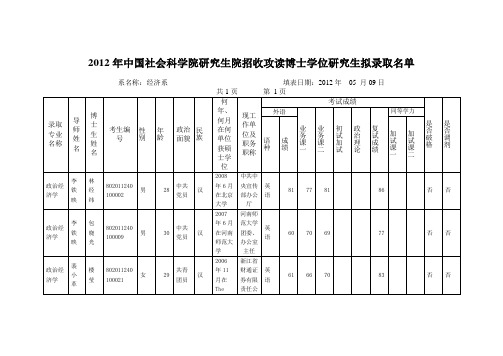
2012年中国社会科学院研究生院招收攻读博士学位研究生拟录取名单系名称:经济系填表日期:2012年05 月09日
2013年中国社会科学院研究生院招收攻读博士学位研究生拟录取名单
系名称(盖章): 经济系 填表日期:2013
年 5 月 14 日
共 1 页 第 1 页
2014年中国社会科学院研究生院招收攻读博士学位研究生拟录取名单
2015年中国社会科学院研究生院经济系招收攻读博士学位研究生拟录取名单
进入拟录取人员名单,最终录取还需研究生院和上级教育主管部门批准。
考生应对所提交的全部材料的真实性和准确性负责,对于提供虚假材料或不提供相关材料者以及其它违反考试纪律的行为,将取消其录取资格。
本资料由社科院内部资料(淘宝网同名店铺)提供
社科院经济学考研考博参考书目、真题答案
社科院801经济学原理和2001经济学原理历年真题解析、历年英语官方真题解析等资料
请淘宝搜索“社科院内部资料”。
中国社会科学院801经济学原理考研试题.doc

99年社会科学院博士入学经济学原理试题一,概念(每题五分):萨伊定律私人物品和公共物品边际消费倾1何公开市场业务二,简答(任选三题,每题十分)简述不完全竞争经济学的发展过程。
试评论结构学派与新古典学派关于发展中国家是否存在隐蔽性失业的争论。
解决外部性的措施都有哪些?在IS.LM模型中,保证产品市场和货币市场可以日动维持平衡的经济机制是什么?三,论述(五十分):试述1998年我国宏观经济政策的特点、作用、意义和结果。
2000年社会科学院博士入学经济学原理试题一、简答题(共70分。
每题10分)1、马克思关于两大部类的划分及其相互关系。
2、简述马克思关于资本积累、资本集聚和资本集+ZIUJ的相互关系。
3、简述我国社会主义的基木经济制度。
4、你如何看待“市场失灵”?5、简述乘数原理和加速原理的相互作川。
6、简述凯恩斯主义的主要经济理论和政策主张。
7、简述1999年度诺贝尔经济学奖得主罗伯特・A•蒙德尔对经济学的贡献。
二、论述题(30分。
不得少于1000字)试述社会主义市场经济中的平等与效率的关系。
谈一谈你对当前宏观经济政策的看法中国社会科学院研究生院2001年社会科学院博士入学经济学原理试题1.马克思的劳动价值论与我国收入分配改革(30分)2.不完全竞争市场的缺陷及政府规制(25分)3.假定投资不受利率影响;利用IS.LM模型和AD-AS模型说明,产出、利率、物价总水平是如何决定的?是怎样发生变化的?(30分)4.阐述1998年度获取诺贝尔经济学奖的主要理论贡献。
(15分)2002年社会科学院博士入学经济学原理试题用总供给和总需求曲线,说明什么情况下产景上升的同时价格下降,什么情况下产量下降的同时价格上升。
二、用图形分析并说明企业的短期成本和长期成本的关系。
三、论述马克思的商品价值向生产价格的转型理论。
四、2001年诺贝尔奖获得者的主要理论贡献及其在现实经济活动中的应用。
1、评论实验经济学对理性行为假设的挑战(30分)2、新经济增长理论的政策含义及其对中国实践的启示。
2024年中国社会科学院大学801经济学考博真题回忆版及答案解析
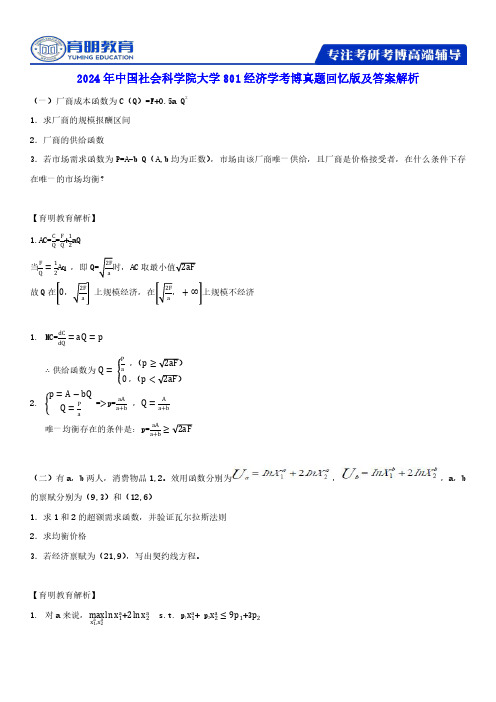
2024年中国社会科学院大学801经济学考博真题回忆版及答案解析(一)厂商成本函数为C(Q)=F+0.5a Q21.求厂商的规模报酬区间2.厂商的供给函数3.若市场需求函数为P=A-b Q(A,b均为正数),市场由该厂商唯一供给,且厂商是价格接受者,在什么条件下存在唯一的市场均衡?【育明教育解析】1.AC=C Q=F Q+12aQ当F Q=12Aq,即Q=2F a时,AC取最小值2aF故Q在0,2F a2F a,+∞上规模不经济1.MC=dC dQ=aQ=p∴供给函数为Q=P a,(p≥2aF)0,(p<2aF)2.p=A−bQQ=P a=>p=aA a+b,Q=A a+b唯一均衡存在的条件是:p=aA a+b≥2aF(二)有a,b两人,消费物品1,2。
效用函数分别为,,a,b 的禀赋分别为(9,3)和(12,6)1.求1和2的超额需求函数,并验证瓦尔拉斯法则2.求均衡价格3.若经济禀赋为(21,9),写出契约线方程。
【育明教育解析】1.对a来说,maxx1a,x2a ln x1a+2ln x2a s.t.p1x1a+p2x2a≤9p1+3p2用lagrangean 乘子法,得:1x 1a =λP 12x 2a =λP 2=>2x 1a P 1=2x 2ap 2代入约束式并取等号解得:x 1a =3+P 2p 1,x 2a =2+6P 1p 2同理,对b 来说,解得:x 1b =4+2P 2p 1,x 2b =4+8P 1p 2∴z 1(P 1)=x 1a +x 1b−21=3P 2p 1−14;z 2(P 2)=x 2a +x 2b−9=14P 1p 2−3∴z 1(P 1)∙P 1+z 2(P 2)∙P 2=0,满足walras 法则2.令z 1(P 1)=0,得:P 2p 1=1433.在契约线上,应有两人的边际替代率相等,即∂U a∂x 1a ∂U a∂x 2a =∂U b∂x 1b ∂U b ∂x 2b ∴1x 1a 2x 2a =121−x 1a 19−x 2a =>9x 1a =21x 2a ,或写成x 2a =37x 1a(以a 的坐标轴)(三)三个小国1,2,3,其中1,2为生产国,3为消费国。
1998年社科院博士生入学考试英语真题及答案
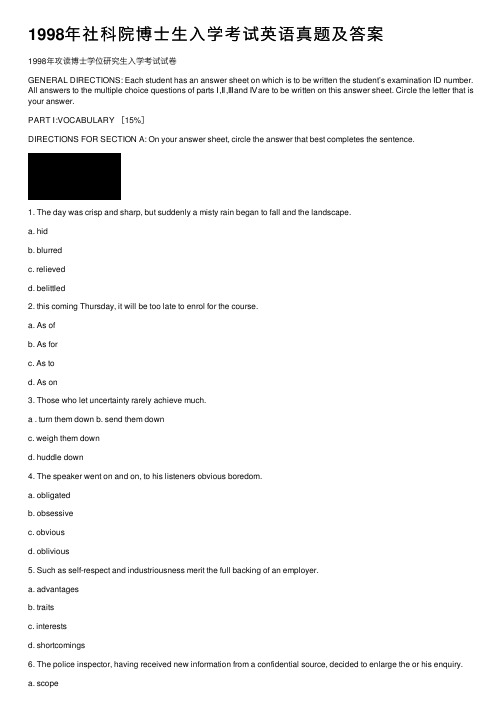
1998年社科院博⼠⽣⼊学考试英语真题及答案1998年攻读博⼠学位研究⽣⼊学考试试卷GENERAL DIRECTIONS: Each student has an answer sheet on which is to be written the student’s examination ID number. All answers to the multiple choice questions of parts Ⅰ,Ⅱ,Ⅲand Ⅳare to be written on this answer sheet. Circle the letter that is your answer.PART Ⅰ:VOCABULARY [15%]DIRECTIONS FOR SECTION A: On your answer sheet, circle the answer that best completes the sentence.1. The day was crisp and sharp, but suddenly a misty rain began to fall and the landscape.a. hidb. blurredc. relievedd. belittled2. this coming Thursday, it will be too late to enrol for the course.a. As ofb. As forc. As tod. As on3. Those who let uncertainty rarely achieve much.a . turn them down b. send them downc. weigh them downd. huddle down4. The speaker went on and on, to his listeners obvious boredom.a. obligatedb. obsessivec. obviousd. oblivious5. Such as self-respect and industriousness merit the full backing of an employer.a. advantagesb. traitsc. interestsd. shortcomings6. The police inspector, having received new information from a confidential source, decided to enlarge the or his enquiry.a. scope7. An intelligent TV viewer may occasionally become enraged by the argumentation in commercials.a. imperativeb. fallaciousc. persuasived. fabulous8. flees if one is constantly subjected to demeaning orders.a. Primeb. Harassmentc. Conceitd. Pride9. popularity of subject matter and frequency of use, the books on the two middle shelves will be the most helpful to you.a. As ofb. As regardsc. As fromd. As against10. I was in my reading, and didn’t at first hear the doorbell ring.a. immuredb. immersedc. busyd. infatuated11. Their chances of winning are slight, given that their opponents are so .a. well-knownb. vitalc. formidabled. distinguished12. When I reach home after an impossible day’s work, I feel a general to watch TV.d. interest13. Fallen electric lines, rubble, ruins and the occasional house--such is the destruction wrought by the war.a. neglectedb. desolatec. tragicd. chopped14. Geographic illiteracy is widespread, and hardly a month passes without from some survey revealing new depths of ignorance.a. wordsb. a wordc. wordd. the word15. of course it is possible that the new policy may have some adverse effects, but it is our that these will be negligible.a. constitutionb. conditionc. convictiond. consideringDIRECTIONS FOR SECTION B: On your answer sheet, circle the letter that is the closest synonym to the underlined word.16. Serial murderers rarely deviate from a certain type of prey.a. attackerb. nourishmentc. victimd. enemy17. The new guppies I bought have just a tinge of yellow.a. dotb. markc. touchd. tingle18. He covered the fish lavishly with sauce.a. sparinglyb. completelyc. generouslyd. simply19. Machiavelli cautions the prince not to relinquish power under passing duress.a. gainb. holdc. controld. abandon20. The play was hilarious!a. a merry oneb. a prudish onec. sedated. prodigious21. The Salk polio vaccine provides immunity from that disease.a. securityb. publicityc. liabilityd. help22. The Smithsonian houses a miscellaneous collection of aircraft, artifacts, butterflies, stones[both precious and common], and so on.a. a heterogeneousb. an overwhelmingc. a unifiedd. a vast23. The jungles of the sub-Sahara, afflicted with tse-tse and mosquitos, is an unhealthy area.a. requiring inoculation againstb. heated byc. flooded byd. plagued by24. He is constantly late, and ill-prepared when he does finally arrive. He is jeopardizing his future.a. developingb. endangeringc. assuringd. destroying25.Chaos theory stresses the magnitude of the results produced by so small an event as the fluttering of a butterfly’s wings.c. resultd. fame26.The ancillary data, however, did not substantiate his argument.a. necessaryb. involuntaryc. subsidiaryd. extraordinary27. Subsequent events vindicated her point of view.a. proved wrongb. indicatedc. proved rightd. invalidated28. Rhenium is added as an alloy inasmuch as it withstands heat.a. dischargesb. resistsc. reducesd. opposes29. At 70, she hardly seems cut-out for mountain climbing.a. chosen forb. fond ofc. likely to enjoyd. fit for1. The elevated roadway collapsed. This calamity could have been avoided had the municipality allocated funds for infrastructure.a. consequenceb. eventc. disasterd. thingPART Ⅱ:GRAMMAR [15%]DIRECTIONS FOR SECTION A: On your answer sheet, circle the letter that best completes the sentence.1. Now that in scientific communities the use of computers is widespread, and supposing that there is sufficient time, there exist no complicated problem can be addressed with some hope of resolution.a. andb. but2. Out of the elementary plane geometry developed by the Greeks we use today.a. the theoretical geometry evolutionb. evolved the theoretical geometryc. the evolution of theoretical geometry camed. the theoretical geometry came3. We had to go miles to find a restaurant, it a holiday.a. beingb. wasc. to bed. is4. A good indication of he followed the teacher’s advice was that he failed.a. what littleb. however littlec. how littled. whatever little5. None of the day’s transactions,sales or delivery, came off well.a. fromb. it beingc. be itd. was it6. The traffic was very heavy, , and so we arrived after the start of the program.a. this was completely unexpectedb. which was completely unexpectedc. that was completely unexpectedd. it was completely unexpected7. , he finds the work interestinga. Though he is computer expertb. A computer expert he isc. As computer expertd. Computer expert as he is8. , he never alters a decision.a. What may comeb. May what comec. Come what mayd. May come whatever9. ‘The car ran out of gas!’‘That the cause, I filled the tank this morning. ’a. mustn’t beb. must have beenc. can bed. can’t have been10. Their proposal is better than ours, .a. all things consideringb. all things consideredc. all things are consideredd. all considered things11. Unless to bend somehow, perhaps with the helps of a mirror, light only travelsstraight ahead.a. you makeb. to be madec. is maded. made12. The sloth is so named for its inactivity, its greatest energy in the search for food. a. it expends b. for expendingc. to expendd. and it expends13. Although most foodstuffs enter the bloodstream only after being subjected to the digestiveprocess beginning in the stomach, alcohol is highly unusual at least one-fifth of the quantity ingested is directly absorbed.a. so thatb. in thatc. thatd. in which14. , we will leave without her.a. If she were to fail to come on timeb. She should fail to come on timec. Should she fail to come on timed. Would she fail to come on time15. My phone call to the electrician as I subsequently discovered my wife hadphoned. My wife had phoned.a. needn’t be madeb. shouldn’t be madec. needn’t have been maded. didn’t have to beDIRECTIONS FOR SECTION B: In the sentences below, either A, B, C or D is the INCORRECT grammatical form for the sentence. Pick the INCORRECT form as your answer, and on your answer sheet, circle the corresponding letter.16.The Mercandiser widget isA so named bec ause itB believed isC discovered be to by Albert Mercandiser, a Dutchman Dby birth. 17. Although the city acquired modernizations ofA recent more a kind during the twentieth century,B its present appearance Cshapes took during D .nineteenth the 18.As she A qrew older her vision B began sporadically to fade, so that intermittent times theC seldom knew what sheD looking was at. 19. A For the grounds that fiction is not B y objectivel true, there C are those who Dobject to it.20.As Christmas approached, with peopleAcrowded department stores, restaurants, theaters and movie houses, the downtown area B was, C , always as theD busiest. 21. A you, Mind under no circumstances B are you to allow your C child to change D broken bulbs by himself.22.Today, I firmly A believe, they B deliver the new television, and if they C do, I D shall help you set up the cable stations.23. TheAyear -f ive project would B expose C l educationa disadvantaged students to Ds experience both creative and enriching. 24. At the museum, I saw various exhibits of Af amily ape members, B was and particularly C struck by one groupD f aces had they resembling humans. 25.So far A is story the from being true that I B surprised was anyoneC believed have could itD was so. 26. To the most famous A alumnae B were extendedC a special invitation to celebrate the fiftieth anniversary ofD their graduation. 27. Whether she is A pretty as , or prettier than B the other girls C in her officeD is moot. 28. A f or But the services provided by B eaters,-insect insects C will make D it impossible to live.29.Unless those currently working –both men and women -- Agiven be would theB necessary training for somewhat higher positions, unemployment in general will becomeC ly increasing more serious as automationD continues . 30. Improved agro-technology rendered Af easible it for far more people To B f ed be per square unit than C can be fed on Dthe produce formerly available in the same area.PART Ⅲ: CLOZE [10%]DIRECTIONS: Choose as your answer the word that best fits the blank. On your answer sheet, circle the corresponding letter.There is no question but that Newton was a highly competent Minister of the Mint. It was mainly through his efforts [1] the English currency was put on [2] satisfactory basis at a difficult time. [3] discovered a relationship between prices and [4] amount of money in circulation, which [5] later formalized in the so-called “quality [6] ”of money: if the amount of [7]In circulation is doubled –other things [8] the same –then prices also will[9] double. This is a simple application [10] the principle that it is impossible [11] get something for nothing, but apparently [12] took someone like Newton to discover it. There [13] an obvious comparison with Copernicus, who [14] the Polish government on currency questions [15]in doing so discovered another important [16] (usually known as Gresham’s Law): when [17] money is accepted as legal tender, [18] money will be driven out of [19] . Copernicus anticipated Gresham in the formulation [20] this law.1. a. which b. why c. that d. for2. a. a b. very c. the d. most3. a. It b. He c. Was d. We4. a. an b. their c. the d. big5. a. too b. was c. they d. has6. a. theory b. them c. thesis d. proposal7. a. coins b. currency c. bills d. gold8. a. stay b. much c. remaining d. be9. a. come b. seem c. multiply d. approximately10. a. for b. of c. calling d. by11. a. our b. to c. for d. we12. a. they b. had c. it d. he13. a. is b. comes c. be d. with14. a. talked b. advised c. formed d. created15. a. from b. but c. and d. by16. a. true b. legend c. theme d. law17. a. much b. foreign c. bad d. lawful18. a. good b. much c. bad d. some19. a. work b. function c. marketing d. circulation20. a. for b. by c. of d. toPART Ⅳ: READING COMPREHENSION [30%]DIRECTIONS: Read each passage and answer all the questions that follow the passage. On your answer sheet, circle the letter that best answers the question.1.There is little question that substantial labor-market differences exist between men and women. Among the most researched difference is the male-female wage gap. Many different theories are used to explain why men earn more than women. One possible reason is based on the limitedgeographical mobility of married women [Robert Frank, 1978]. Family mobility is a joint decision in which the needs of the husband and wife are balanced to maximize family welfare. Job-motivated relocations are generally made to benefit the primary earner in the family. This leads to a constrained job search for the secondary earner, as he or she must search for a job in a limited geographic area. Since the husband is still the primary wage earner in many families, the job search of the wife may suffer. Individuals who are tied to a certain area are labeled ‘tied-stayers,’while secondary earners who move for the benefit of the family are labeled ‘tied-movers’[Jacob Mincer, 1978].The wages of a tied-stayer or tied-mover may not be substantially lower if the family lives in or moves to a large city. If a large labor market has more vacancies, the wife may locate a wage offer near the maximum she would find with a nation-wide search. However, being atied-stayer or tied-mover can lower the wife’s wage if the family lives in or moves to a small community. A small labor market will reduce the likelihood of her finding a job that utilizes her skills. As a result she may accept a job for which she is overqualified and thus earn a lower wage. This hypothesized relationship between the likelihood of being overqualified and SMSA size is termed ‘differential overqualification. ’Frank [1978] and Haim Ofek and Yesook Merrill [1994] provide support for the theory of differential overqualification by finding that the male-female wage gap is grater in smaller SMSA’s.While the results are consistent with the existence of differential overqualificatio n, they may also result from other situations as well. Firms in small labor markets may use their monopsony power to keep wages down. Local demand shocks are found to be a major source of wage variation both across and within local labor markets [Robert Topel, 1986]. Since large labor markets are generally more diversified, a demand shock can have a substantial impact on immobile workers in small labor markets. Another reason for examining differential overqualification involves the assumption that there are more vacancies in large labor markets. While there is little doubt that more vacancies exist in large labor markets, there are also likely to be more people searching for jobs in large labor markets. If the greater number of vacancies is offset by the larger number of searchers, it is unclear whether women will be more likely to be overqualified in small labor markets. Instead of relying on wages to determine if differential overqualification exists, we consider an explicit form of over qualification based on education.1. In the author’s opinion, the male-female wage gapa. is the most important difference.b. is justified.c. has important repercussions on family life.d. represents a sexist attitude toward women.e. is simply one of a considerable number of labor-market differences.2.‘Geographic mobility,’as used in the text, refers toa. the way in which Americans tend to move from job to job.b. the penchant wage-earners have to maximize family welfare.c. the necessity to relocate in order to increase wages.d. all of the above.e. none of the above.3. In the author’s opinion, which of the following statements is true?a. The term ‘secondary earner’ does not depend on gender.b. If A will earn more money than B, family welfare is maximized if B agrees to relocate.c. If B will earn more money than A, family welfare is maximized if A agrees to relocate.d. All of the above are true.e. None of the above are true.4.The difference between a ‘tied-stayer’and ‘tied- mover’is that.a. the former is the husband and the latter is the wife.b. the primary earner is forced to search for work in a specific area while the secondary earner is freer to roam about.c. the former is obliged to remain in an area while the latter not.d. the former is the wife and the latter is the husband.e. the latter’s salary is of secondary importance to the former’s salary.5. With which of the following statements would the author agree?a. The size of the labor market determines recompense.b. The size of the labor market determines acquired skills utilization.c. The size of the labor market determines the probability of matching skills withappropriate wage level.d. The author would agree with all of the level.e. The author would agree with none of the above.6. The names and dates between parenthesesa. refer to bibliographical entries.b. explain who discussed what and when they discussed it.c. are references to what the author has read.d. may be described by all of the above.e. may be described by none of the above.2.] The repression in the Netherlands, instead of solving a crucial problem, elicited bitter criticism from every major European state. Alba was unrepentant about his tough policy convinced than the population must remain in a state of fear, ‘so that every individual has the feeling that one fine night or morning the house will fall in on him.’Of the leading dissidents who escaped from Alba’s hands, only William of Orange remained. Tall, dark-haired, with a small moustache and a short peaked beard, the prince of Orange-Nassau was aged thirty-five at the moment that fortune left him in the unenviable role of defender of his country. A comrade-in-arms of Philip during the latter’s years abro ad inmid-century, he never made a secret of his concern for the privileges of his class or of his dislike for religious dogmatism. Widowed in 1558, in 1561 he married Anne, the Lutheran daughter of the late Maurice of Saxony. The marriage, celebrated in Leipzig, gave him a useful link with the princes of the Holy Roman Empire. When news came of Alba’s departure from Spain, Orange opportunely took refuge in Germany. It became clear that the only way to regain the Netherlands was by the use of them. In the course of 1568 Orange sponsored invasions by several small forces, which entered from France and from Germany. All were defeated. Captured prisoners gave details of Orange’s links with protestants in several countries. The invasions could not fail to affect the fate of the distinguished prisoners in Alba’s hands. On 5 June 1568, in the public square of Brussels, the counts of Egmont and Hornes were beheaded for high treason.The executions shocked opinion throughout Europe. The two nobles, as knights of the Golden Fleece, could be tried only by their peers. But Philip, grand master of the order, had cleared the way for the trial by a special patent which he had drawn up in April 1567 and sent to Alba in December. There is no doubt that Philip considered Egmont responsible for much of the trouble in Flanders, but the pressure for an exemplary punishment came rather from themembers of his council, particularly [it seems] from cardinal Espinosa. Alba had always regretted the need to arrest the two counts, whom ‘‘I have always loved and esteemed as my own brother. ” According to some, he was reluctant to proceed to execution. Philip wrote formally to Alba: “I very deeply regret that the offenses of the counts were so serious that they called for the punishment tha t has been carried out.” The remorse, which came too late, was probably sincere. The counts were victims of a political crisis. Their names, interestingly enough, continued to be held in honour at the Spanish court. A book on the events of Flanders published in Castile a few years later, when all books had to be licensed by the royal council, referred to them as “outstanding princes, well loved and of the highest and finest character.”1. ‘Bitter criticism’is criticism that isa. sour.b. major.c. angry.d. vinegary.e. none of the above.2. The repression in the Netherlands was wrought bya. minor European states.b. Alba.c. William of Oranged. all of the above.e. none of the above.3. We may assume thata. the prince of Orange-Nassau was married twice.b. the marriage was premised upon political consideration.c. some of the princes of the Holy Roman Empire were protestants.d. the counts of Egmont and Hornes were decapitated in retaliation for the invasions.e. all of the above are true.4. Philipa. travelled to various countries in the mid-16th century.b. was the chief officer of the knights the Golden Fleece.c. was Alba’s superior.d. may have reluctantly acceded to the beheading.e. may be described by all of the above.5. Which of the following is true?a. In the text, Flanders and the Netherlands are two completely separate entities.b. Cardinal Espinosa was instrumental in swaying Philip’s councilc. Philip was personally opposed to the punishment.d. All of the above are true.e. None of the above are true.6. The deaths of the two countsa. were caused more by the political situation than by their actions.b. did not destroy their reputations in Spain.c. were brought about by their brother, Alba.d. may be described by none of the above statements.e. may be described by [a] and [b].3.] Despite efforts to provide them with alternatives such as the shelter, women frequently andrepeatedly returned to violent and abusive partner. By the late 1970s, feminists at Women Together, like those doing similar work throughout the United States, began to understand that battered women experience a range of post-traumatic psychological responses to abuse, similar to those of victims of other types of violence or trauma. Subsequently, the psychological response of battered women became reified as “battered woman syndrome,”a sub-category of post-traumatic stress disorder. Interestingly, in the course of trying to create social change, the focus of feminists perceptibly shifted to trying to explain why battered women fail to leave the partners who beat them. In trying to address this question, a debate ensued among feminists and mental health workers as to potential merits and problems of categorizing as mental disorder what many feminists labeled a normal response to fear and an appropriately angry response to abuse. Although many women left abusive relationships or successfully ended violence by other means, some responded to ongoing or accelerated abuse by killing or trying to kill their male partners. In many states, when they went to trial, such women found they were restricted from introducing testimony about the abuse they had endured or their resulting states of mind. In trying to address these women’s ne eds, some activists and scholars advocated the use of expert testimony to explain battered woman syndrome to juries. This strategy would introduce evidence of past abuse and challenge the gender biases of self-defense law by explaining the woman’s stage of mind at the time of the offense. Feminist legal scholars raised potential problems in the use of battered woman syndrome. They argued that it could be used against women who did not neatly fit pre-established criteria and had the potential to become another example of the tendency to label women’s normal angry responses as mental illness. While the desirability of working to admit expert testimony was debated, individual state courts and legislatures varied in their willingness to recognize battered woman syndrome, permit evidence of past abuse, or allow expert testimony. As the legal debate about battered women’s responses to violence was beginning to unfold, the Ohio movement became directly involved in it when a former shelter resident shot and killed her abusive common law husband. In 1978 women Together, in conjunction with the woman’s lawyer, decided to challenge existing law by trying to introduce battered woman syndrome expert testimony at trial.Because at the time the syndrome had little scientific merit or legal recognition, the trial court declared inadmissibility, a decision upheld by the State supreme Court (State v. Thomas 1981 66 Ohio St. 2d 51).Women Together founders left the shelter to establish professional careers, viewing this as a means of advancing the feminist agenda. The frustrations, limitations and defeats they had experienced as outside challengers impelled them to adopt a strategy of infiltration and appropriation of the institutions they sought to change. For example, on founder, who had worked through lobbying for ERA America in addition to her other feminist activism, explained her decision to run for elected office by saying:“[When ERA was defeated] I decided to run for the legislature. I said I can do better than these turkeys.”1. Battered woman syndrome isa. a psychological response.b. a sub-category of a specific stress disorder.c. similar to that experienced by a range of victims.d. all of the above.e. none of the above.2. Generally speaking, women who are beatena. address questions to feminists.b. return to their male partners.c. require an explanation for the beating.d. leave their partners.e. do none of the above.3. A debate arose as to whethera. feminists of mental health workers were correct.b. battered wives should return to their husbands.c. anger and fear were appropriate or inappropriate.d. focus should be shifted.e. all of they above.4. Responses to abuse by male partners includea. leaving them.b. killing them.c. other means.d. all of the above.e. none of the above.5. The use of expert testimonya. depends on the situation.b. is a way around legal restrictions.c. is required by state laws in women’s trials.d. is a way of ending abuse by other means.e. may not be defined by any of the above.6. We may assume that prior to the period discussed self-defensea. applied to men only.b. posed a problem for the battered woman syndrome.c. refers to expert testimony.d. includes all of the above.e. includes none of the above.7. The word “turkeys”a. refers to the bird that Americans eat at Thanksgiving.b. is an unflattering reference to other law-makers.c. is an unflattering reference to the speaker herself.d. will be explained in the following paragraph.e. refers to none of the above.4.] The position of Burleigh School in the English educational system would be very difficult to explain to a foreigner (who has, God knows, enough to contend with in comprehending the other parts of the system). Nor would it be possible to refer him to any works of literature (before the present one) from which he could gain enlightenment. The prep schools have had their Orwell, the public schools their Connolly and Benedictus, the convent schools their Antonia White, the private boarding schools their Waugh and Nicolas Blake. No one has thought it worth their while to eulogize or anathematize schools like Burleigh. Indeed, schools like Burleigh do not seem the sort of places from which writers emerge.And yet, any medium-sized town in the southern half of England has its Burleigh School: a private day school to which, for a not too exorbitant fee, parents can send their children and boast that they are privately educated. Not well educated, but privately. Burleigh itself had beenfounded – no, started – between the wars, had survived the Depression (as the South of England middle classes in general had so signally managed to coast blithely through the Depression) and had offered over the years an alternative to the Grammar, Secondary Modern and Technical Schools of the town of Cullbridge. Which meant, in effect, that though some parents chose to send their children there rather than to the Grammar School, many more sent them there because they failed their eleven-plus, that Beecher’s Brook of English childhood. With the coming of comprehensive education three years before, even the faint whiff of privilege attached to the Grammar School had evaporated, a fact on which Burleigh had been able to capitalize, in a mild way.Foreigners are always apt to find charming the examples they come across of quaint anachronisms, of dated anomalies, in English life. One such charming and dated anomaly is that a school like Burleigh can be bought. A man – any man – can buy such a place, set himself up as headmaster, and run it as he likes. Indeed, that is precisely what Edward Crumwallis had done. He had bought it from its previous aging owner/ headmaster in 1969 and had been there ever since. This must not be taken to imply that Edward Crumwallis was unfit for his position. He was in fact a BA (3rd class, Geography), from the University of Hull (graduated 1948). Still, scholarship was not exactly his thing. He might take the odd class in Geography in a pinch, but he had never given the subject any particular prominence in the school, and most boys gave it up after two years. Nor was Crumwallis anxious to take over periods in other subjects when there was need--as in cases of sickness or (frequently) death. Since his graduation he had not cultivated Learning. He had cultivated Manner. He had bought Burieigh (which he invariably called The Burleigh School, in capitals) preciselty so that his manner might be given free reign and ample pasturage. A very good manner it was too, with parents – decidedly impressive. It certainly impressed those of limited intelligence, among whom may be numbered Crumwallis himself. He really believed in it: he not only thought that others should remain silent during his threadbare pontifications, but he actually believed they would benefit from them. Such a conspicuous lack of self-knowledge had its dangers.Not that the Manner – which he intended should be so admired later in the week on Parents’ Evening -- was particularly in evidence on the Monday, as he sat at his study desk and went over the plans for that event with his wife. The side of Edward Crumwallis that was most evident during such t·te-·-t·tes was the pretty-minded, niggling side that side of his psychological profile that was seldom turned in the parents’ direction.“The question is, shall we splurge on the coffee and scrimp on the tea, or vice versa,”he said.1. Orwell, Connolly, Benedictus, Antonia White, Waugh and Nicolas Blakea. are the names of different schools.b. taught at schoolsc. eulogized or anathematized their schools.d. are reflected in all of the above.e. are explained by none of the above.2. Burleigh Schoola. is relatively expensive.。
2005年社科院经济学原理考博试题(暂缺答案)

2005年社科院经济学原理考博试题(暂缺答案)(总分:100.00,做题时间:180分钟)一、名词解释(每题5分,共20分,答案每题不能少于30字)(总题数:4,分数:20.00)1.环比价格指数(chain price index)(分数:5.00)__________________________________________________________________________________________正确答案:()解析:2.萨谬尔森均衡(Samuelson Equilibrium)(分数:5.00)__________________________________________________________________________________________正确答案:()解析:3.铸币税(Seigniorage)(分数:5.00)__________________________________________________________________________________________正确答案:()解析:4.试验经济学(Experimental economics)(分数:5.00)__________________________________________________________________________________________正确答案:()解析:二、简答(每题10分,共20分,答案不少于300字)(总题数:2,分数:20.00)5.新古典宏观经济学与新凯恩斯主义经济学的基本理论有哪些主要区别?(分数:10.00)__________________________________________________________________________________________正确答案:()解析:6.简述比较优势原理的基本要点。
社科院801经济学原理2010-2018年历年真题
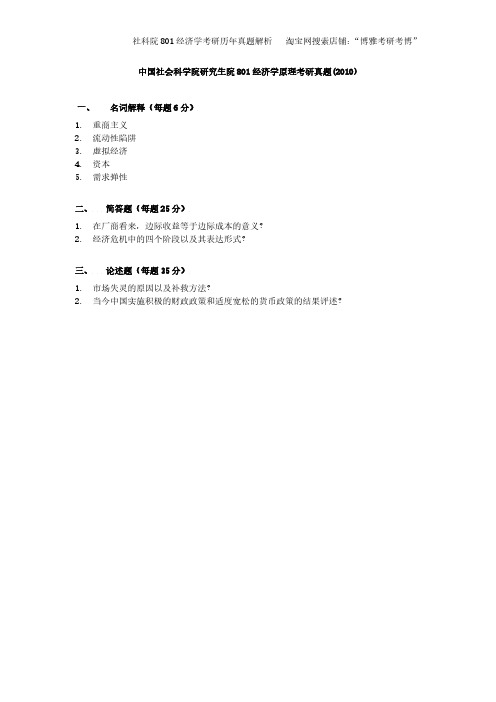
中国社会科学院研究生院801经济学原理考研真题(2010)一、名词解释(每题6分)1.重商主义2.流动性陷阱3.虚拟经济4.资本5.需求弹性二、简答题(每题25分)1.在厂商看来,边际收益等于边际成本的意义?2.经济危机中的四个阶段以及其表达形式?三、论述题(每题35分)1.市场失灵的原因以及补救方法?2.当今中国实施积极的财政政策和适度宽松的货币政策的结果评述?一、名词解释(每题6分,共30分)1.商品2.财富效应3.规模收益递增4.拉弗曲线5.布雷顿森林货币体系二、简答题(每题25分,共50分)1.简述剩余价值率与利润率的区别和联系。
2.简述经济增长和经济发展及两者的联系。
三、论述题(每题35分,共70分)1.边际效用递减规律适用于所有商品吗?为什么?2.论述我国当前实施积极的财政政策和稳健的货币政策的基本依据和涵义。
一、名词解释(每题6分,共30分)1.吉芬商品2.法定准备金率3.寡头垄断市场4.隐蔽性失业5.不变资本二、简答题(每题25分,共50分)1.马克思政治经济学中的“按劳分配”中“劳”的基本涵义。
2.画出图形并描述什么是“厂商收支相抵点”及现实意义。
三、论述题(每题35分,共70分)1.用杜森贝利的相对收入理论分析我国居民的超前消费的现象。
2.试论价格的收入分配效应。
一、名词解释(每题6分,共30分)1.需求价格弹性2.资本有机构成3.囚徒困境4.可变资本5.边际转换率二、简答题(每题25分,共50分)1.简要说明商品输出与资本输出的联系与区别2.运用图表简释完全竞争与垄断竞争的市场效率差异。
三、论述题(每题35分,共70分)1.简述边际成本与边际效益相等时的厂商决策。
2.运用菲利普斯曲线分析和说明通货膨胀与失业的一般关系。
一、名词解释(每题5分,共30分)1.基尼系数2.菲利普斯曲线3.寻租4.工资粘性5.挤出效应6.MRTS二、简答题(每题25分,共50分)1.简述垄断竞争厂商的均衡条件。
- 1、下载文档前请自行甄别文档内容的完整性,平台不提供额外的编辑、内容补充、找答案等附加服务。
- 2、"仅部分预览"的文档,不可在线预览部分如存在完整性等问题,可反馈申请退款(可完整预览的文档不适用该条件!)。
- 3、如文档侵犯您的权益,请联系客服反馈,我们会尽快为您处理(人工客服工作时间:9:00-18:30)。
1998一、概念1、自然失业率2、挤出效应3、边际替代率4、经济租二、简答1、用AVC与MC的关系说明完全竞争企业的短期产量决策。
2、简述储蓄与投资的关系。
3、简述市场经济条件下政府在经济活动中的作用和干预方式。
三、论述论述90年代以来我国宏观经济特征和产业组织状况的变化。
1999一、概念1、萨伊定律2、私人物品和公共物品3、边际消费倾向4、公开市场业务二、简答1、简述不完全竞争经济学的发展过程。
2、试评结构学派与新古典学派关于发展中国家是否存在隐蔽性失业的争论。
3、解决外部性的措施有那些?4、在IS—LM模型中,保证产品市场和货币市场可以自动维持平衡的经济机制是什么?三、论述试论述1998年我国宏观经济政策的特点、作用、意义和结果。
2000一、简答题1、马克思关于两大部类的划分及其相互关系。
2、简述马克思关于资本积累、资本集聚和资本集中的相互关系。
3、简述我国社会主义的基本经济制度。
4、你如何看待“市场失灵”(Market failures)?5、简述乘数原理和加速原理的相互作用。
6、简述凯恩斯主义的主要经济理论和政策主张。
7、简述1999年度诺贝尔经济学奖得主罗伯特.孟德尔(Robert A. Mundell)对经济学的贡献。
二、论述题1、试论社会主义市场经济中的平等与效率的关系。
2001简答1、马克思的劳动价值论与我国收入分配改革。
2、不完全竞争市场的缺陷及其政府规制。
3、假定投资不受利率影响,利用IS--LM模型和AD--AS模型说明,产出、利率、物价总水平是如何决定的?是怎样发生变化的?4、阐述1998年度诺贝尔经济学奖的主要理论贡献。
2002年论述1、用总供给和总需求曲线,说明什么情况下产量上升的同时价格下降,什么情况下产量下降的同时价格上升。
2、用图形分析说明企业的短期成本和长期成本的关系。
3、论述马克思的商品价值向生产价格的转型理论。
4、 2001诺贝尔获奖者的主要理论贡献及其在现实经济活动中的应用。
2003年(每题必答1000字以上)1、评论实验经济学对理性行为假设的挑战(30分)2、新经济增长理论的政策含义及其对中国实践的启示。
(35分)3、运用政治经济学原理解析中共十六大报告关于“确立劳动、资本、技术和管理等生产要素按贡献参与分配的原则,完善按劳分配为主体、多种分配方式并存的分配制度”的精神。
(35分)2004年一、名词解释(每题5分,共20分)1、需求弹性2、基尼系数3、汇价4、垄断二、简要回答(每题10分,共20分)1、人力资本投资的边际收益是递增的么?2、何谓帕累脱效率准则?三、论述(每题30分,共60分。
每题答案不少于1000字)1、简论生产要素按贡献分配与商品价值决定的关系。
2、简述宏观调控体系中的财政、货币政策及其作用机理。
2005年一、名词解释(每题5分,共20分,答案每题不能少于30字)1、环比价格指数(chain price index)2、萨谬尔森均衡(Samuelson Equilibrium)3、铸币税(Seigniorage)4、试验经济学(Experimental economics)二、简答(每题10分,共20分,答案不少于300字)1、新古典宏观经济学与新凯恩斯主义经济学的基本理论有哪些主要区别?2、简述比较优势原理的基本要点。
三、论述(每题30分,共60分。
每题答案不少于1000字)1、剩余价值的生产过程是劳动过程与价值增值过程的统一。
2、当前我国出现的“民工荒”及其政治经济学涵义。
社科院2006博士入学经济学原理考试题一、名词解释(4*5=20分)1 无差异曲线2 流动性陷阱(相对剩余价值)3 菲利普斯曲线4 资本有机构成二、问答题(2*15=30分)1 加速原理及其基本要点。
2 外延式粗放型经济增长与内涵式集约型经济增长的异同点三、论述题(2*25=50分)1 垄断资本主义特点“恰恰不是工业资本的统治,而是金融资本的统治”。
2 科学发展观的基本内涵及其实践意义。
2007年社科院经济学原理试题一、概念解释6分每题1、折旧2、垄断寡头3、流动性陷阱4、消费者剩余5、资本项目二、简述题15分每题1、剩余价值生产既不发生在流通领域,又不能离开流通领域。
2、巴罗-李嘉图等价命题的基本要点三、论述题论述消费和投资的关系以及在当前我国的表现形态及评价。
2008年社科院经济学原理试题一、概念解释6分每题1、再贴现率2、劳动力价值3、重商主义4、适应性预期5、全要素生产率二、简述题15分每题1、试论市场经济条件下,私人提供公共物品的六种方式2、列宁说过“垄断天生有停滞和腐朽的趋向”,试论其历史和现实意义三、论述题40分试论地租和土地所有权关系理论及其现实意义2009年经济学试题一、名词解释(5×6)吉芬商品国际收支虚拟资产庇古效应剩余价值率二、简答(15×2)1、试用平均总成本、平均可变成本、边际成本曲线说明厂商的收支平衡点和停止营业点2、试用持久性收入理论说明个人收入和消费支出的关系三、论述(40 二选一)1、对财政政策和货币政策的四种政策组合和运用环境进行评述。
2、对凯恩斯的“三大心理假说”和“有效需求不足”的机制进行评述。
2010年考博真题-经济学原理一、名词解释(30字以上)需求价格弹性边际收益递减广义货币M2 布雷顿森林体系绝对剩余价值二、简答(500字以上)1、垄断竞争市场的性质和特征2、马克思主义经济危机理论三、论述(二选一,1000字以上)1、通货紧缩的产生与治理2、提高居民在国民收入分配比重,缩小收入差距的意义(政府报告中的话)2011 经济学原理试题一、名词解释(4‘*5)劳动生产率消费者剩余边际成本价格指数赤字率二、简答(15’*2)1、马克思的劳动二重性与价值的决定2、市场失灵的原因与应对措施三、论述(50)二选一1、西方经济学的预期与通货膨胀理论,如何降低通货膨胀的预期。
2、“努力提高居民收入在国民收入分配中的比重、劳动报酬在初次分配中的比重”的政治经济学内涵及现实意义。
2012年社科院考博经济学原理一、名词解释(30字以上)1、生产函数2、菲利普斯曲线3、供给的价格弹性4、汇率5、级差地租II二、简答(500字以上)1、列宁关于“垄断天生停滞与腐朽”,“阻碍技术进步”的论断对我国的现实意义。
2、说明边际消费倾向和平均消费倾向的联系和变化关系。
三、论述(二选一,1500字以上)1、财政政策的自动稳定器对我国经济调控的现实意义。
2、论述外延式经济增长和内涵式经济增长的联系和区别以及外延式经济增长向内涵式经济增长的转变。
2013年经济学原理一、名词解释(每题5分,共30分,不少于30字)1.囚徒困境(博弈论)2.边际技术替代率(MRTS)3.绝对地租4.寡头垄断5.社会扣除6.商品拜物教(选自资本论)二、简答(每题15分,共30分,不少于600字)1.论述总需求、总供给管理的机制及异同。
(供给经济学派)2.论述对劳动是商品价值唯一源泉的理解。
三、论述(共 40分,二选一,不少于1500字)1.试用政治经济学和现代经济学比较生产率理论说明我国收入分配现状,贫富差距拉大原因及解决措施。
2.提供了很多资料、信息,试用经济增长模型说明内生增长对于我国经济结构调整的重要性,并借用全要素生产率这一理论框架进一步解释说明。
西方经济学真题2013年一、简答1.2007年次贷危机后,我国与多国签署货币互换。
简要评价2.评价中国的影子银行3.差额,万能和分红型保险的异同二、论述2013年2月份中国货币供应量M2超过100万亿,与GDP的比例居于世界前列,试分析之。
2011年一、简答(3选1,每题20分,共60分)1、法定存款准备金率2、巴塞尔协议33、特别提款权4、还有一个保险的题目,不记得了二、论述(40分)1、审慎宏观政策2009年1. 评述西方银行金融危机中的国有化措施2. 简述货币政策的信贷传导途径3. 论述国际货币体系的发展沿革及今后的改革方向2007年巴塞尔协议的三大支柱的内容及意义(30分)如何看待当前的流动性过剩?(30分)如何看待中国外汇储备管理体制改革。
(40分)2006年解释资产证券化的原理。
(30分)试述金融创新的动因。
(30分)解释中国银行业近期存贷比不断扩大的原因。
(40分)2005年1、试述互换的基本原理及其主要类型。
(30分)2、试述中央银行独立性。
(30分)3、我国资本充足率管理的主要内容及其对商业银行的影响。
(40分)2004年1、存款准备金制度的源流及发展趋势。
(30分)2、资本结构定理的主要内容。
(30分)3、金融稳定的主要内容及金融稳定的政策体系。
(40分)2003年1、试述米什金的金融结构八大迷团。
(30分)2、试述债券定价的三大原则及其运用,并举例说明。
(30分)3、购买力评价理论的发展沿革及其对中国汇率制度的指导意义。
(40分)。
